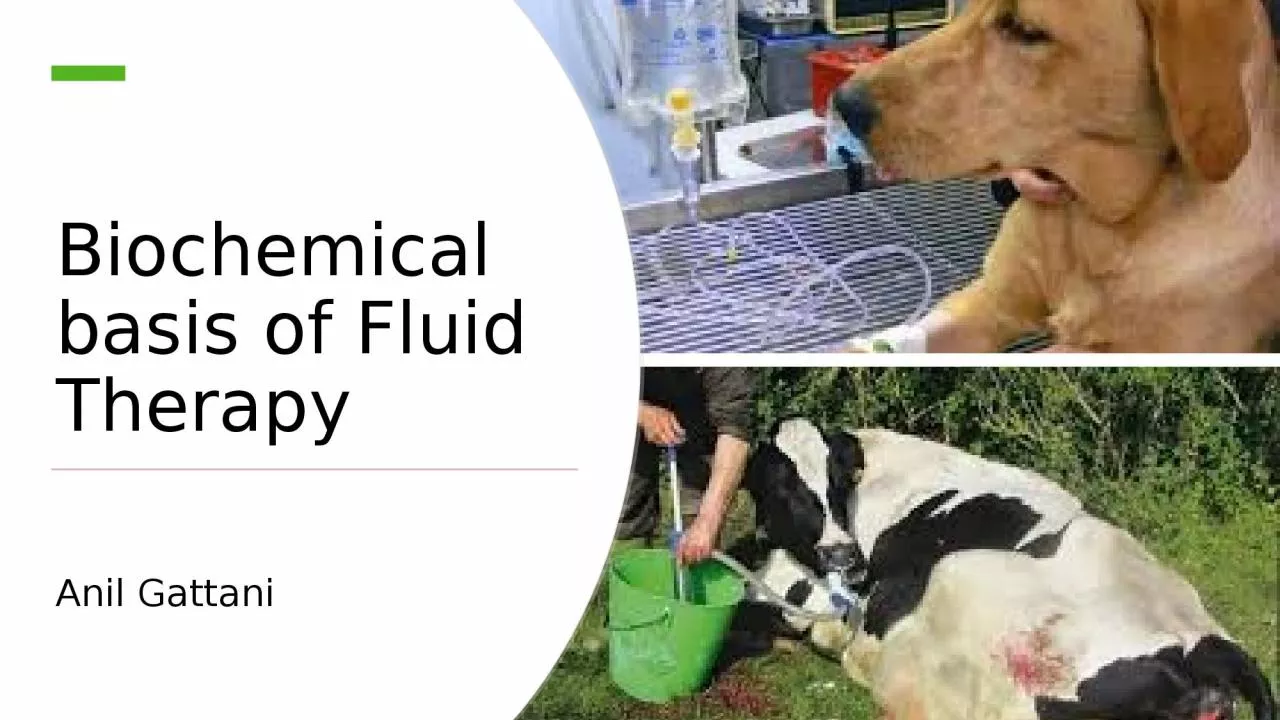

Anil Gattani Indication of Fluid therapy instituted for the following conditions Dehydration loss of skin elasticity dry buccal mucosa and tongue and sunken eyeballs Acidbase disturbances vomiting diarrhea abnormal respiratory pattern and CNS abnormality ID: 999606
Download Presentation The PPT/PDF document "Biochemical basis of Fluid Therapy" is the property of its rightful owner. Permission is granted to download and print the materials on this web site for personal, non-commercial use only, and to display it on your personal computer provided you do not modify the materials and that you retain all copyright notices contained in the materials. By downloading content from our website, you accept the terms of this agreement.
1. Biochemical basis of Fluid TherapyAnil Gattani
2. Indication of Fluid therapyinstituted for the following conditionsDehydration- loss of skin elasticity, dry buccal mucosa and tongue, and sunken eyeballsAcid–base disturbances - vomiting, diarrhea, abnormal respiratory pattern, and CNS abnormalityElectrolyte imbalances- Blood gas and urine analyses Nutritional problemsLoss of body fluids- burn, haemorrhage,
3. DehydrationHypertonic dehydration- loss of pure water or hypotonic fluidIsotonic dehydration - loss of isotonic body fluids (in acute case), Hypotonic dehydration - loss of a hypertonic fluid or loss of isotonic fluid with water replacement
4. Causes of dehydarationDecreases in water intake – Lack of water source, Disorders and pain of the buccal cavity and pharynx, CNS disturbancesIncreases in body fluid excretion Polyuria, Profuse sweating, Vomiting/diarrhea, Respiratory loss
5. Role of electrolytes on hydration states and acid–base balance↑ [Na+] in ECF → water retention↑ [K+] in plasma→↑[K+],↓[H+] in urine → Acidemia↓ [K+] in plasma→↓[K+],↑[H+] in urine → Alkalemia
6. Role of carbohydrate metabolism on hydration states and acid–base balance↓ Carbohydrate utilization → Hyperglycemia → Glucosuria→ Polyuria → Dehydration↓ Carbohydrate utilization →↑ Gluconeogenesis → Ketoacidosis↑ Carbohydrate intake (grain overload) in herbivores →↑ Lactic acid production → Acidosis
7. Water replacementAmount of fluid therapy = body water maintenance + replacement of the deficit + ongoing lossMaintenance water= 50–75 mL/kg/day (Average 65)Ongoing loss- vomiting, diarrhoea, etc
8. replacement of the deficit
9. composition of replacement fluid similar to the volume of fluid lostE.g. if loss of the electrolyte-rich GI fluid, then fluid should contain Na+, K+, Ca2+, Cl−, and (or indirect alkalinizing agents)In pure loss of water- 5% dextrose (glucose in water) or 2.5% dextrose and 0.45% NaCl over 24–72 hours
10. Other factorsDehydration affects young animals much faster than adultOld animals with chronic diseases require more water than youngerPhysical and weather conditions may affect the requirementDrugs will alter requirements, particularly diuretics and mineralocorticoids
11. Calculation of mOsm/L from mMFor electrolyte solutions Since NaCl dissociates into two particles, Na+ and Cl−, 1 mmol/L (1 mmolar or 1 mM) of NaCl solution yields 2 mOsm/L 1mmol of NaCl contains 58.5 mgFor nonelectrolyte solutions glucose does not dissociate, 1 mM of glucose solution yields 1 mOsm/L
12.